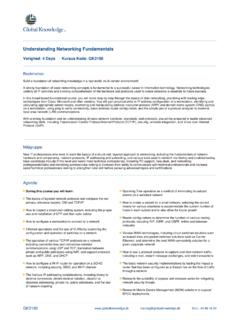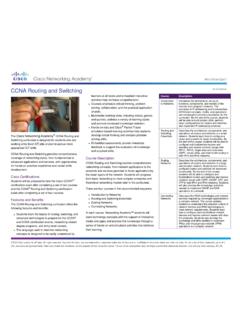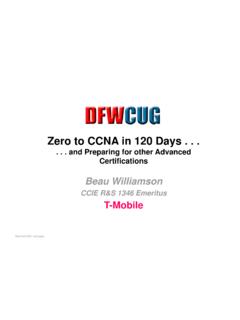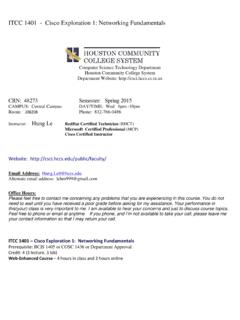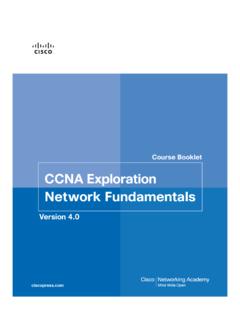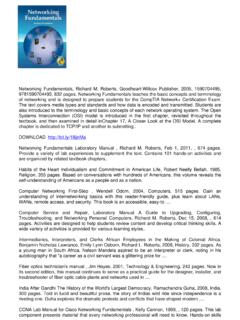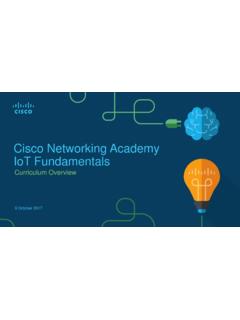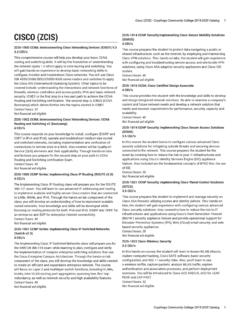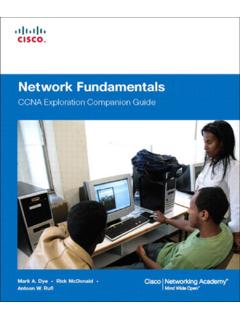Transcription of Basics of TCP/IP, Switching, Routing and …
1 Basics of TCP/IP, switching , Routing and this article ?After reading the following question at least a gazillion times: My DCC is not working .. can anyone help me pls ??, i have been thinking about the cause or causes of this 'problem' for quite some time of the people asking this question did everything alright configuring the Chat-Client or other applications they are using to connect to the internet. DCC or other network-services should be working fine, but they don' most common reason for the problems those people are facing is, in my honest opinion, a not properly configured piece of the network. Due to this, the 'information' needed by the 'other side' (remote host) is not being transmitted over the network (In this case the network is the 'bad, bad' Internet.), or the packages send by the remote host are not reaching the network in which the requesting computer (local host) have a better understanding why this is happening, one has to know what the different networking devices are doing with the network traffic they send and network that people think they are using will (simplified) basically look like this: Local hostRouter1 InternetRouter2 Remote Host Most people connecting to the internet nowadays are using a nice little thing they call a Router or DSL-Router.
2 This is where some of the problems Is this nice little nifty device only a Router? Or is there more behind it?To understand what this wonderful piece of technique is capable of we need to know a bit more about the different pieces a little home network is made of and how they where to start? Imagine a user somewhere on this world, sitting behind a computer, pushing the power-button, waiting for the OS coming up, then starting his or her favourite browser (which i hope is Mozilla Firefox ;)) and starts typing after doing this hitting the enter-key. What happens The German starting-page of the searching machine google appears on the screen in front of that user. Now that's easy? Isn't it :) was this really as easy as it looked like? Definitely not ;)To understand what happens we will need a bit of theory. I'll try to keep this as brief as Ethernet local area network (LAN) is essentially a (logical) bus based broadcast network; though the physical implementation may use hubs (with a physical star topology).
3 As one would expect, broadcast LANs must deal with collisions; either by preventing them or detecting them and taking appropriate action. Token based LANs avoid collisions by only allowing one host at time to transmit (the host that currently has the token may transmit). Standards that relate to LANs are primarily the IEEE series. For instance, is the Media Access Control (MAC) standard for (Carrier Sense Multiple Access with Collision Detection) CSMA/CD (the Ethernet standard); while is the MAC standard for Token Ring. Just above the MAC level is the Logical Link Control ( ) standard and above that it the High Level Interface ( ) standard. Within a LAN, addressing is done with a MAC address. Between LANs (connected over the Internet (WAN (Wide Area Network)), having Routers in between) using TCP/IP, addressing is done using IP addresses. If you are lost at this point, keep reading because much of this will be explained below ;)The OSI-ModelAfter TCP/IP was well-established and other networking protocols, such as DECnet and Novell s IPX were operational, the International Standardization Organization (ISO) developed the Open Systems Interconnection (OSI) seven layer reference following list details the seven layers of the Open System Interconnection (OSI) reference model: OSI-Layer NameFunctional DescriptionExamples Layer 7 ApplicationInterface between network and applicationTelnet, HTTP, software.
4 WWW-Browsers Layer 6 Presentation How data is presented, , ASCII Layer 5 Session Establishing maintaining and managing end-Operating systemsto-end bidirectional flows between endpoints. Application access Layer 4 Transport Reliable or unreliable delivery, , UDP, SPX Layer 3 Network Logical addressing, which routers use forIP, IPXpath determination Layer 2 Data link Combination of bits into bytes, and bytes Access to media using detection and error recovery. Layer 1 PhysicalMoving bits between devices. Specification ofEIA/TIA-232,voltage, wire speed and cable seven layers of the OSI reference model can be divided into two categories: upper layers and lower upper layers of the OSI model deal with application issues and generally are implemented only in software. The lower layers of the OSI model handle data transport issues. The physical layer and the data link layer are implemented in hardware and software. The lowest layer, the physical layer, is closest to the physical network medium (the network cabling, for example) and is responsible for actually placing information on the wide variety of communication protocols exist.
5 Some of these protocols include LAN (Local Area Network) protocols, WAN (Wide Area Network) protocols, network protocols, and Routing protocols. LAN protocols operate at the physical and data link layers of the OSI model and define communication over the various LAN media. WAN protocols operate at the lowest three layers of the OSI model and define communication over the various wide-area media. Routing protocols are network layer protocols that are responsible for exchanging information between routers so that the routers can select the proper path for network traffic. Finally, network protocols are the various upper-layer protocols that exist in a given protocol suite. Many protocols rely on others for operation. For example, many Routing protocols use network protocols to exchange information between given layer in the OSI model generally communicates with three other OSI layers: the layer directly above it, the layer directly below it, and its peer layer in other networked computer systems.
6 The data link layer in System A, for example, communicates with the network layer of System A, the physical layer of System A, and the data link layer in System B. Now, lets go back to our little example. A user somewhere on this world pushes the power button of his computer. The computer starts his BIOS (Basic Input Output System) and does a POST (Power On Self Test) after doing a few more tests it searches for the OS (Operating System) and starts other words, this computer is running through the OSI-Model from bottom to top. Starting with layer one and having reached layer five when the Basics of the OS are running. Now the GUI (Graphical User Interface) is started and this computer runs through the layers six and seven. Why is this computer already running on layer seven of the OSI-Model? It's simple, hence: the GUI of Microsoft OS Windows is which is an application. Now the web browser is started, the user types and hits the enter-key.
7 This data is processed from top to bottom of the OSI-model and send over the Home Network Now that we have come this far, it's time to break up our little home network into piece's and have a closer look at the single start with the thing your are probably sitting in front of, reading this ComputerAs we already know this is a nice piece of technique that is capable of running on all seven layers of the OSI-model. Why is this important? You will see in a device allows you to run applications (OSI-layer 7) and is capable of sending data over the network using the NIC (Network Interface Card) which is running on OSI-layer has the NIC to be a OSI-layer 2 device? It's simple, it has a hardware decoded MAC-address and has, when it's not a wireless one, a piece of cable plugged in, connecting it to a hub or switch. It does not know anything about IP-addresses, port numbers and the protocol that is probably running in the little home (Transport Control Protocol/Internet Protocol) is a protocol suite that is implemented in the OS you are using and is running on OSI-layer 3 and 4 the network and transport layer.
8 TCP/IP is responsible for you having an IP-address and delivers the possibility to the computer to communicate with other systems using IP-addresses, a subnetmask, portnumbers and a default ability that your computer can run at OSI-layer 4 using TCP/IP makes it possible to use this device to run a firewall on it. Most of you will have at least one firewall running on the computer when having installed Windows XP SP2. This firewall is active by default and could be a possible cause for blocking traffic you'd rather like to get. (See we are getting to the point now ;))Most users connecting to the internet don't know that one firewall, though it isn't a good one in my opinion, is already up and running, so they download a third-party product, like Zone Alarm. They install this firewall, and not really knowing what they are doing, they click on allow or block this or that application or traffic. Having a second, probably misconfigured, firewall up and to the fact that most people know that viruses can be really nifty things and are, without proper knowledge, not easy to remove from an infected system.
9 They purchase or download an antivirus product (like Bitdefender, NortonAV), not knowing that nowadays most of these software packages have a build in firewall that is installed up and running by default. To be sure that no virus can infect the computer, they use several products from different vendors, or they install different products from cd's/dvd's coming with computer magazins. Now already 3-4 (or even more) firewalls are running on the computer!When scrolling back up to the little network at the beginning of this article i think this one already needs a revision;)The next part of the home network is the network-cable connecting the computers NIC to the hub or switch. Could this piece of the network be responsible for the connectivity problems? Yup !! When it's broken or not connected, because it's a OSI-layer 1 piece of it ;)OK let's presume the cable isn't causing the problems. The next piece of our network would be the hub or and SwitchesWhat is the difference between a hub and a switch, how do they work and could they be responsible for parts of the data transmission not working like it should?
10 Most people think of hubs and switches being kind of a multiple socket outlet for connecting computers. Basically this is true for most of the devices used in small home/office a hub receives a data packet, it 'shouts' it out of all ports, beside the one he received the packet on. So all computers connected to the hub are receiving that packet. It does not matter if that packet had that destination or not. How does a computer know if that little packet was determined for him or not? That's very the computers NIC reads out the destination MAC-address in the packets header and accepts the packet when it's his MAC, otherwise the NIC drops the packet. Because of this a hub is working on layer 2 of the OSI-model. It cannot be responsible for not letting through any packets received by this to the fact that hubs are causing a lot of unnecessary networking traffic switches were switch 'learns' the MAC-addresses of the computers NIC's connected to his ports, writing them down in a MAC-address table.
